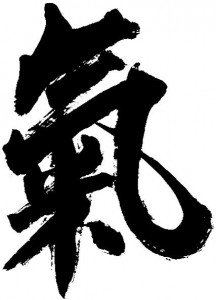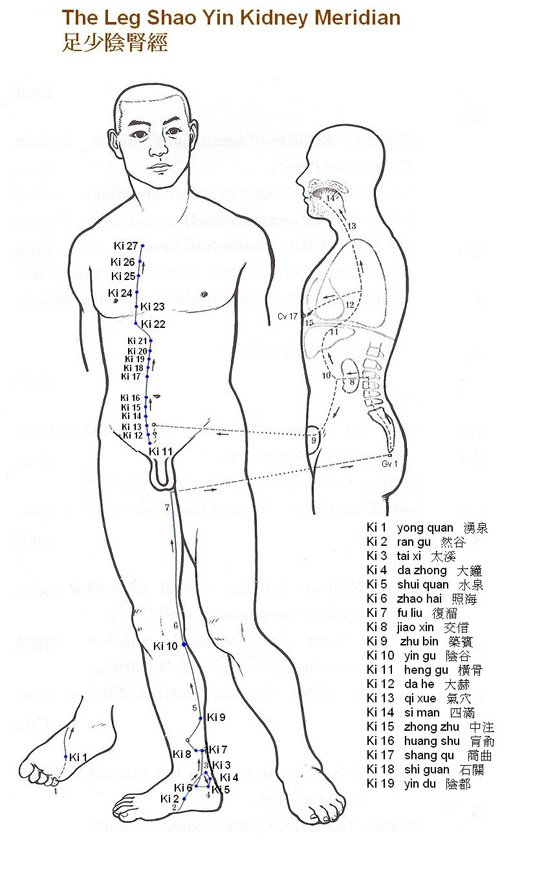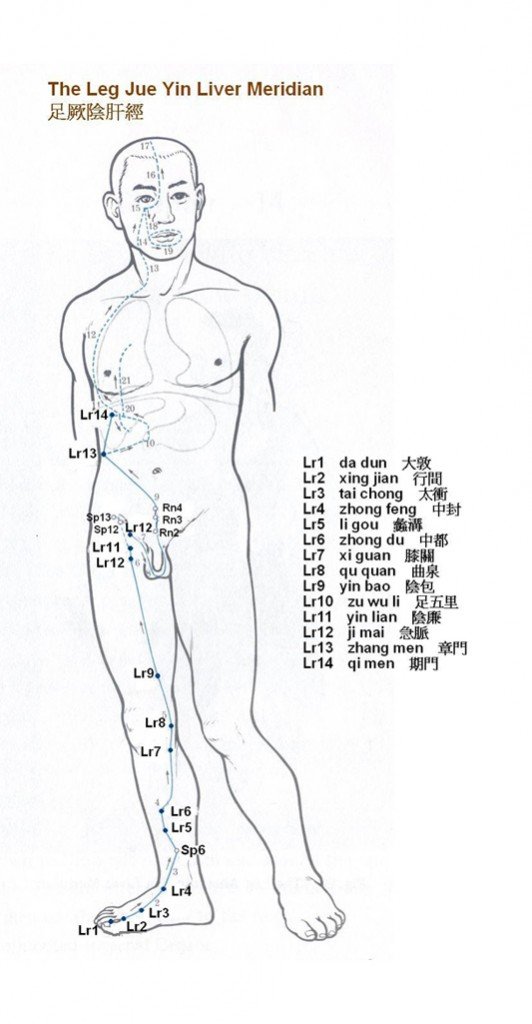Scientific Qi Exploration – Horary Cycle Qi Pathways from 3 p.m. to 3 a.m. (Part III)
by Marty Eisen Ph.D.
The Meridian pathways of the Qi flow in the Horary Cycle, from 3 p.m. to 3 a.m., is described below. Recall that each Organ and its corresponding Meridian energy is at its peak during a two hour period in the Horary Cycle, and is at its minimum during the two hour period twelve hours later.
The flow is maximal in Bladder Meridian from 3 p.m. to 5 p.m. and then in the Kidney Meridian from 5 p.m. to 7 p.m. and so on, flowing in the order in which the Meridians are described below.
11. The Bladder (Foot-Taiyang) Meridian (B)
See http://www.acumedico.com/bladder.htm
The Bladder Meridian starts from B1 (Jingming), .1 cun superior to the inner canthus. Ascending to the forehead, it joins the Du Meridian at Du 20 (Baihui) after passing through B 7 (Tongtian) but before B 8 (Luoqque). Two branches emerge from Du 20, on the midline of the head, 5 cun above the anterior hairline. One runs to the temple and the other enters the brain and emerges to join the external Meridian. The external Meridian bifurcates at B 10 (Tianzhu), .5 cun above the posterior hairline (PHL) and 1.3 cun lateral to the midline on the lateral aspect of the trapezius. The branches descend along the posterior aspect of the neck.
One branch runs alongside the medial side of the scapula and parallel to the vertebral column down the back from B 41 (Fufen) to B 52 (Zhishi) and passes through the gluteal region, meeting G 30 (Huantiao) at the junction of the lateral 1/3 and medial 2/3 distance between the prominence of the greater trochanter and the hiatus of the sacrum. It continues down the posterior aspect of the thigh to meet the other branch at B 40, at the midpoint of the transverse crease 0f the popliteal fossa.
The second branch from B 10 runs parallel to the first branch, midway between the first branch and the vertebral column, down the back from B 11 (Dazhu) to B 30 (Baihuanshu) in the gluteal region. It then turns upward to reach B 31 (Shangliao), then turns down to run through the gluteal region and the posterior thigh. It descends lateral to the first branch and then crosses it, passing through B 39 (Weiyang), medial to the biceps femoris tendon, and finally meeting the first branch at B 40.
An internal branch arise from the second external branch at B23 (Shenshu) and enters the body through the paravertebral muscles to connect with the Kidney and join the Bladder, its pertaining Organ.
The external branch from B 40 descends to the calf, to the posterior aspect of the medial malleolus, and then runs along the tuberosity of the fifth metatarsal to reach B 67 (Zhiyin), on the lateral side of the small toe, about .1 cun posterior to the nail’s corner. B 67 is the point linking the Bladder Meridian with the Kidney Meridian.
12. The Kidney (Foot-Shaoyin) Meridian (K) 
See http://www.acumedico.com/kidney.htm
The Kidney Meridian starts at B 67 and runs obliquely from the inferior aspect of the little toe towards the sole to K 1(Yongquan), located between the second and third metatarsal bones, approximately one third of the distance between the base of the second toe and the heel, in a depression formed when the foot is plantar flexed. Emerging from the depression on the lower border of the tuberosity of the navicular bone at K 2 (Rangu), it runs behind the medial malleolus at K3 (Taixi) to the heel at K 4 (Dazhong). Then, it ascends along the medial side of the leg to
K 9 (Zhubin) and to the medial side of the popliteal fossa to K 10 (Yingu). Then, it runs further upward along the postero-medial thigh towards Du 1 Changqiang), midway between the tip of the coccyx and anus. There it runs upward to enter the Kidney, its pertaining Organ, and then descends to the Bladder and returns to K 11 (Hengu), 5 cun below the navel on the superior border of symphysis pubis, .5 cun lateral to the midline of the body.
From K 11, the external Meridian ascends the abdomen and chest to terminate in K 27 (Shufu), in the depression on the lower border of the clavicle, 2 cun lateral to the midline.
A branch emerges from the Kidney ascends, passes through the Liver and diaphragm, enters the Lung, runs up along the throat and terminates at the root of the tongue.
A branch emerges from the Lung, joins the Heart and flows into the chest to link with the Pericardium Meridian.
13. The Pericardium (Hand-Jueyin) Meridian (P)
See http://www.acumedico.com/pericardium.htm
The Pericardium Meridian originates in the chest and enters its pertaining Pericardium Organ. Then, it descends through the diaphragm to the abdomen connecting with the Upper, Middle and Lower Burners or the Sanjiao.
A branch arising from the chest runs inside the chest and emerges at P 1 (Tianchi), in the fourth intercostal space, 1 cun lateral to the nipple. It ascends to the P 2 (Tianquan), 2 cun below the end of the anterior axillary fold, between the two heads of the biceps brachii muscles. From P 2, it descends the medial aspect of the upper arm, between the Lung and Heart Meridians, to P3 (Quze), on the transverse cubital crease, at the ulnar side of the tendon of the biceps brachii muscle. Continuing down the forearm, it passes between the tendons of the palmaris longus and flexor carpi radialis muscles, ending in the palm at P 8 (Laogong), on the transverse crease of the palm, between the second and third metacarpal bones. From there it traverses the middle finger to terminate at P 9 (Zhongchong), in the center of its tip.
Another branch arises from P8, runs along the ring finger to SJ 1 (Guanchong) on the ulnar side, about .1 cun posterior to the corner of the nail, to link with the Triple Burner (Sanjiao) Meridian.
14. The Sanjiao (Hand-Shaoyang) Meridian (SJ)
See http://www.acumedico.com/sanjiao.htm
The Sanjiao Meridian originates at SJ 1 and runs upward on the dorsum of the hand, between the fourth and fifth metacarpals, to SJ 4 (Yangchi) on the transverse wrist, in the depression lateral to the tendon of the extensor digitorum communis muscle, and continues on the lateral aspect of the forearm between the radius and ulna to SJ 10, in the depression when the elbow is flexed about 1 cun superior to the olecranon. It continues along the lateral aspect of the upper arm until it reaches SJ 14 (Jianliao), at the origin of the deltoid muscle, in the depression which lies posterior and inferior to the lateral extremity of the acromion. Turning toward the medial upper corner of the scapula, it crosses the Gallbladder Meridian, circles down to the supraclavicular fossa, enters the chest to connect with the Pericardium Organ and descends through the diaphragm to the abdomen to join the upper, middle and lower Jiao, its pertaining Organ.
A branch form the chest flows upward, emerges from the supraclavicular fossa, connects to
SJ 17 (Yifeng), posterior to the lobule of the ear, in the depression between the mandible and mastoid process, runs along the posterior border of the ear and further to the anterior corner of the hairline. Then, it descends to the cheek to terminate in the infraorbital region.
Another branch arises from SJ 17 and enters the ear from SJ 21, in the depression anterior to the supratragic notch, just above the condyloid process of the mandible. Then, it emerges in front of the ear connecting with SJ 22 (Erheliao) and reaches SJ 23 (Sizhukong), in the depression at the lateral end of the eyebrow, to link with G 1 (Tongziliao), .5 cun lateral to the outer canthus, in the depression on the lateral side of the orbit.
15. The Gallbladder (Foot-Shao Yang) Meridian (G)
See http://www.acumedico.com/gb.htm
The Gallbladder Meridian originates from the outer canthus of the eye at G 1, ascends to the corner of the forehead to G 4 (Hanyan), curves downward around the posterior of the ear to G 12 (Wangu), ascends to G 14 (Yangbai) on the forehead, 1 cun directly above the midpoint of the eyebrow and circles down to G 20 (Fengchi), in the depression between the sternocleidomastoid and the trapezius muscles, level with a horizontal line passing directly below the external occipital protuberance. It runs down along the side of the neck in front of the Sanjiao Meridian to G 21 (Jianjing) on the crest of the trapezius directly above the nipple, curving to the back it crosses and passes behind the Sanjiao Meridian down through the supraclavicular fossa and the latera side of the chest to G 22 (Yuanye) on the mid-axillary line when the arm is raised, 3 cun below the axilla. The external Meridian zigzags downward from G 22 to G 24 (Riyue) to G 25
(Jingmen), on the lower border of the free end of rib 12, to G 28 (Weidao) to G 29 (Juliao) to reach G 30 at the junction of the lateral 1/3 and medial 2/3 of the distance between the greater trochanter and the hiatus of the sacrum.
Another branch arises from G 12, behind the ear, and goes to G 2 (Tinghui), anterior to the intertragic notch, at the posterior border of the mandible, and enters the ear. This is why G 2 is often used for ear problems. Then, it reemerges and flows through the preauricular region to the posterior aspect of the outer corner of the eye.
Still another branch arises from the outer canthus, descends to S5 on the anterior border of the masseter muscle, in the groove appearing when the cheek is bulged, and crosses the Sanjiao Meridian. It passes through S 6 (Jiache), about one finger width (middle finger) anterior and superior to the angle of the mandible at the belly of the masseter muscle with teeth clenched, descends the neck and enters the supraclavicular fossa where it meets the main Gallbladder Meridian. From there it runs down into the chest, passes through the diaphragm to connect with the Liver Organ and enters the Gallbladder Organ. Then, it flows inside the hypochondriac region, emerges at the lateral side of the lower abdomen near the femoral artery in the inguinal region. Next, it runs superficially along the hair of the pubic region to cross down to G 30.
From G 30, the main external meridian descends the lateral aspect of the thigh to G 33 (Xiyangguan) lateral to the knee joint, between the tendon of the biceps femoris and the femur. Running further down from G 34 (Yanglingquan), in the depression anterior and inferior to the head of the fibula, it travels along the anterior aspect of the fibula to G 39 (Xuanzhong), 3 cun above the tip of the external malleolus, in the depression between the posterior border of fibula and the tendons of the peronaeus longus and brevis muscles, to reach G 40 (Qiuxu), anterior and inferior to the external malleolus, in the depression on the lateral side of the tendon of the extensor digitorum muscle. Then, flowing along the dorsum of the foot, between the fourth and fifth metatarsals it reaches G 44 (Zuqiayin), on the lateral side of the fourth toe, .1 cun posterior to the nail’s corner.
The branch linking to the Liver Meridian originates from G 41 (Zulinqi), in the depression distal to the junction of the fourth and fifth metatarsals, lateral to the tendon of extensor digiti minimi muscle, runs between the first and second metatarsals terminating in Liv 1 (Dadun), on the lateral side of the dorsum of the big toe, between the lateral corner of the nail and the interphalangeal joint.
16. The Liver (Foot-Jueyin) Meridian (Liv)
See http://www.acumedico.com/liver.htm
The Liver Meridian starts from Liv 1, on the lateral side of the terminal phalanx of the big toe, 0.1 cun from the corner of the nail, runs upward along the dorsum of the foot to Liv 4, 1 cun anterior to the medial malleolus, in the significant depression just medial to the tendon of tibialis anterior when the ankle is dorsiflexed, ascends to Liv 6 (Zhongdu), 7 cun above the tip of the medial malleolus, on the midline of the medial surface of the tibia. It crosses the Spleen Meridian to reach Liv 7 (Xiguan), 1 cun posterior to the depression formed by the tibia and the lower border of its medial condyle, in the upper portion of medial head of the gastrocnemius muscle. It ascends to Liv 8 (Ququan), in the depression above the medial end of the popliteal crease (formed when the knee is flexed), on the anterior part of the insertion of the semimembranosis and semitendinosis muscles, posterior to the medial epicondyle of the femur.
Then, it runs further upward along the medial aspect of the thigh to reach Liv 12 (Jimai), 1 cun inferior and 2.5 cun lateral to the pubic spine, in the inguinal groove where the pulsation of femoral artery is palpable. The main external Meridan continues up to Liv 13, (Zhangmen), on the lateral side of the abdomen, below the free end of the eleventh rib, and ends on the chest at Liv 14 (Qimen), in the sixth intercostal space, directly below the nipple.
A branch arises from Liv 12, goes to the pubic hair region, curves around the external genitalia, enters the abdomen, runs upward through the abdominal wall to reach the Liver, its pertaining Organ. Four branches are formed in the Liver Organ.
The first and the shortest branch, flows to tis associated Yang Organ, the Gallbladder.
The second, short branch penetrates the diaphragm and enters the Lung Organ, where it connects to the Lung Meridian to complete the Horary Cycle, as shown in Fig. 1.
The third and largest branch penetrates the diaphragm, goes up the side of the inner chest wall and along the back part of the larynx. Then, it enters the posterior nasal tract and enters the tisues around the eyes. Running further upward, it emerges from the forehead and meets the Du Vessel at the vertex.
Another branch arises from the tissues of the eyes, descends into the cheek and curves around the inner surface of the lips.
The fourth branch is probably a branch of the third branch, before it penetrates the diaphragm. It runs to the top of the Liver Organ, toward the side of the abdomen and descends in the abdominal cavity to end at the level corresponding to Liv 13.
References
1. Johnson, J.A. Chinese Medical Qigong Therapy. Int. Institute of Medical Qigong, Pacific Grove, CA, 2000.
2. Zu Bing andWang Hongcai, Eds. Basic Theories of Traditional Chinese Medicine. Singing Dragon, Philadelphia, PA, 2010.
3. Chen Youbang, et al, eds. Chinese Acupuncture and Moxibustion. Foreign Language Press, Beijing China, 1990.
4. Omura, Y. Acupuncture Medicine: Its Historical and Clinical Background. Japan Publications, Inc., Tokyo, Japan, 1982.
5. Jarret, L. J. The use of entry and exit points in traditional acupuncture.
http://www.spiritpathpress.com/chinese-medicine-books/articles/article_entryexit.pdf
6. Amaro, J. A. Contemporary Applications for Jet Lag from Ancient Principles ! http://www.iama.edu/JetLag/JetLag.htm
 Marty Eisen, PhD – a retired scientist, who constructed mathematical models in medicine. He has studied and taught Yoga, Judo, Shotokan Karate, Aikido, Qigong, Praying Mantis Kung Fu, and Tai Chi. Dr. Eisen studied Chinese Medicine through apprenticeships and correspondence courses . His latest project is to help arrange free courses for veterans in Chow Qigong for health or as a vocation – see http://eastwestqi.com/. For more information about Dr. Eisen please visithttp://home.comcast.net/~carolezak
Marty Eisen, PhD – a retired scientist, who constructed mathematical models in medicine. He has studied and taught Yoga, Judo, Shotokan Karate, Aikido, Qigong, Praying Mantis Kung Fu, and Tai Chi. Dr. Eisen studied Chinese Medicine through apprenticeships and correspondence courses . His latest project is to help arrange free courses for veterans in Chow Qigong for health or as a vocation – see http://eastwestqi.com/. For more information about Dr. Eisen please visithttp://home.comcast.net/~carolezak
